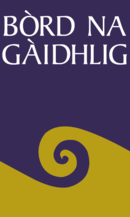Bòrd na Gàidhlig
 | |
| Non Departmental Public Body overview | |
|---|---|
| Jurisdiction | Scottish Government |
| Headquarters | Darach House, Stoneyfield Business Park, Inverness, IV2 7PA |
| Employees | 23 |
| Annual budget | £5.46 million (2010-11) |
| Non Departmental Public Body executive |
|
| Website | Official website |
Bòrd na Gàidhlig ([pɔːrˠt̪ nə kaːlɪikʲ] ![]() listen ) is the executive non-departmental public body of the Scottish Government with responsibility for Gaelic.[1] It was established in 2003 and is based in Inverness. It is not to be confused with Comunn na Gàidhlig or An Comunn Gaidhealach, which are much older.
listen ) is the executive non-departmental public body of the Scottish Government with responsibility for Gaelic.[1] It was established in 2003 and is based in Inverness. It is not to be confused with Comunn na Gàidhlig or An Comunn Gaidhealach, which are much older.
Structure
Bòrd na Gàidhlig is a non-departmental public body constituted of members of the board, whose role is "to provide leadership, direction, support and guidance" to the body, and staff who are typically full-time public sector employees and who carry out the day-to-day work of the body. The head of the board is the cathraiche (chairperson) and the head of the staff is the ceannard (chief executive).[2]
History
In 2006 Bòrd na Gàidhlig was designated as the body responsible for implementing the Gaelic Language (Scotland) Act 2005 and specifically, as stated in the Act, "securing the status of the Gaelic language as an official language of Scotland commanding equal respect to the English language".[3] The Bòrd represents a cornerstone of the Scottish Government's implementation of their duties under the European Charter for Regional or Minority Languages.
The first cathraiche of the eight member Bòrd was Donnchadh MacFhearghais (Duncan Ferguson) from Islay, rector of Plockton High School, former convenor of Comunn Luchd-Ionnsachaidh, Comunn na Gàidhlig, and director of the steering committee for BBC Gaelic programming. In March 2012, following the resignation of Arthur Cormack, who had been appointed in February 2009 after holding the position of interim Chair from July 2008, Elizabeth McAtear was appointed by the Bòrd as interim Chair before the full recruitment process for a replacement Chair.[4]
Aims and duties
Its primary aims are
- to increase the number of Gaelic speakers
- to strengthen Gaelic as a language of community and home
- to promote Gaelic in Scotland's cultural life, and
- to develop the use of Gaelic in every aspect of Scottish life
Its duties are
- to develop a strategic National Gaelic Plan
- to work with organisations with an interest in the language
- to consult on a strategy for Gaelic Medium Education
Following a consultation period from October 2003 to January 2004, during which many respondents expressed their concern that any advice Bòrd gives would be likely to be ignored by largely hostile authorities, it was announced in September 2004 that the Bòrd was to be strengthened in several areas:
- the Bòrd's guidance to local authorities on Gaelic medium education will be statutory;
- it can advise all public, private and voluntary bodies;
- it will decide on how to focus Gaelic language development and will determine which organisations should produce language plans.
See also
References
- ↑ "About the 'Bòrd na Gàidhlig' (English) ", gaidhlig.org.uk, 2006, Retrieved 5 April 2010
- ↑ Bòrd na Gàidhlig Framework Document. Retrieved 22 July 2015.
- ↑ Gaelic Language (Scotland) Act 2005, http://www.legislation.gov.uk/asp/2005/7/contents, retrieved 24-6-2011
- ↑ "Statement on Bòrd na Gàidhlig and the resignation of Arthur Cormack from the Scottish Government". Scottish Government. 7 March 2012. Retrieved 7 March 2012.
External links
- Official website (Scottish Gaelic)
- Official website (English)
